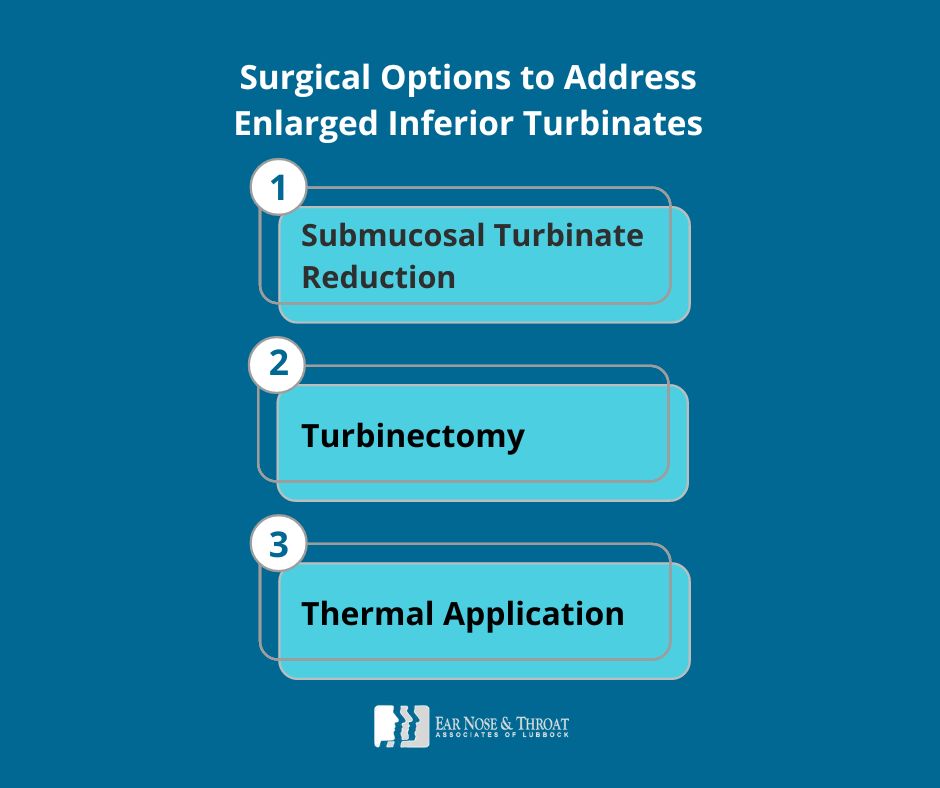Your Options for Treating Swollen Turbinates

Being able to breathe through your nose is easy to take for granted. But when structures within your nasal passageways swell and impede normal breathing, it’s impossible to ignore. Among those structures are turbinates.
Swollen turbinates make your nose feel stuffy, often forcing you to breathe through your mouth, which can be really uncomfortable. They can even contribute to headaches and sleep disorders like snoring and obstructive sleep apnea if left untreated.
Let’s take a closer look at congestion from swollen turbinates to determine why it happens and what you can do about it.
What Are Turbinates?
Turbinates are structures made of bone and soft tissue. They sit along your nasal walls opposite the septum, which separates your nostrils into right and left sides.
You might have noticed that the word “turbinate” is similar to the word “turbine.” That’s because, very basically, turbinates affect the airflow in the nose.
Each of your nostrils has three turbinates: inferior, middle, and superior. The inferior turbinates most directly affect airflow because they’re situated further down toward the opening of your nostrils. Normally, there’s a space between the septum and the turbinates that allows air to pass through your nose so you can breathe with no problems.
Turbinates serve an important function. Their job is to filter, moisten, and warm air as it passes through your nose to your throat. Without them, breathing would be much more uncomfortable, coming with a rush of cold as air passed through your nose. Not pleasant!
What Happens When Turbinates Swell?
Everyone has a natural nasal cycle. One side of your nose will always be more congested than the other, and which side it is changes every few hours.
The problem begins when turbinates become so swollen that they prevent air from flowing in. At that point, they’ve become counterproductive. Since turbinates sit right in the midst of your nasal passages, any swelling can easily obstruct your breathing.
Several causes can trigger turbinate swelling, including:
- Allergies (environmental or food)
- Respiratory tract infections
- Sinus infections
- COVID-19
- A cold or the flu
- Pregnancy or other hormonal fluctuations
- The natural aging process
- Prolonged Afrin or topical decongestant usage
What Non-Surgical Treatments Are Available?
ENT doctors typically treat swollen turbinates on a case-by-case basis. That means they look at your symptoms and the efficacy of previous treatments you’ve tried to develop an individualized treatment plan for you.
Most often, we start by treating allergies with medications like oral antihistamines, topical decongestants, or topical antihistamines.
- Antihistamines block the effects of histamines, which are chemicals in your immune system that cause sneezing, itchiness, watery eyes, or a runny nose to help your body expel allergens like pollen and pet dander.
- Decongestants work by narrowing your blood vessels, which shrinks the swollen tissue inside your nose so air can pass through more easily.
Most antihistamine and decongestant combinations are available over the counter (OTC), but some require a prescription from your doctor. An ENT doctor can also give you detailed instructions on how and when to use these medications for the best results.
If allergies cause your turbinates to swell, you can limit your exposure to your allergens as much as possible. Some helpful tips include:
- Remove excess dust and pet dander from your home.
- Don’t smoke indoors.
- Use specialized cleaners to remove any mold and mildew in your bathrooms, kitchen, or basement.
- Use a high-efficiency particulate air (HEPA) filter inside your home. (especially in your bedroom or wherever you sleep.)
If these OTC treatments and environmental adjustments work to reduce the size of your swollen turbinates, you’ll be able to breathe normally through your nose, and surgery won’t be necessary.
When Should I Consider Surgery for Swollen Turbinates?

Sometimes OTC treatments don’t work, and people still experience nasal congestion. If this is the case for you, it may be time to consider turbinate reduction surgery.
The following surgical treatments are minimally invasive, safe, and can address enlarged inferior turbinates:
- Submucosal turbinate reduction: This is the most common turbinate surgery. It’s usually an outpatient procedure performed under general anesthesia, but some advanced practices offer this procedure in the office with local anesthesia. During this procedure, an ENT doctor uses an endoscope (a small medical device with a light and camera on it) to see inside your nose. Then, they make a small incision in the mucosal lining of each inferior turbinate and remove the tissue causing the swelling.
- Turbinectomy: With this procedure, the ENT doctor removes the bottom half of each inferior turbinate with a tiny, high-speed device. You’re sedated during the entire procedure, so it’s pain-free. Turbinectomies used to be the preferred surgical treatment for addressing swollen turbines, but have fallen out of fashion because taking too much tissue out of the nose can make nasal breathing uncomfortable. However, sometimes it’s necessary for excessively swollen turbinates.
- Thermal application: An ENT doctor may also use heat to shrink swollen turbinates. This option is more commonly used with children because their noses are small, and there’s minimal space to insert surgical instruments into their nostrils. Instead, the ENT doctor will insert a probe into the turbinate to heat and shrink it.
Recovery from turbinate surgery usually takes about five to seven days. You might experience some nasal congestion during this time, but that’s normal. Nasal irrigation can help reduce congestion and speed up the recovery process.
You might also have some nasal discharge after surgery. If it’s yellow, green, or accompanied by a cough or fever, it may be a sign of infection and you should call your ENT doctor.
An ENT Doctor Can Help You Get Relief
If you’re frequently stuffed up and can’t breathe through your nose, swollen turbinates may be the cause. An experienced ENT doctor can review your treatment options and help you determine which one is best for you. Getting rid of that pesky stuffy nose might be easier than you thought!
Dr. Cuthbertson is a physician at Ear Nose & Throat Associates of Lubbock. He joined the team at ENT Lubbock from Houston, where he was chief resident of the prestigious Bobby R. Alford Department of Otolaryngology at Baylor College of Medicine. He is board certified in Otolaryngology and Head & Neck Surgery and has quickly built a reputation, not only as an extremely skilled surgeon, but as an approachable and compassionate clinician adept in the newest standards and technologies. Learn more about Dr. Cuthbertson.
Categories:







